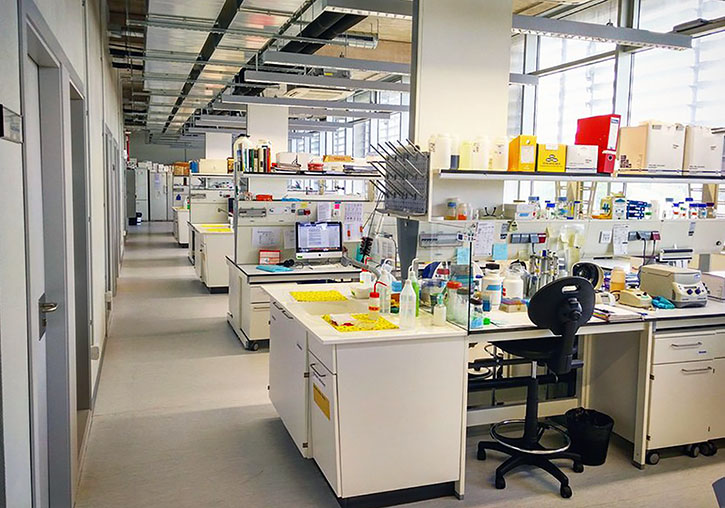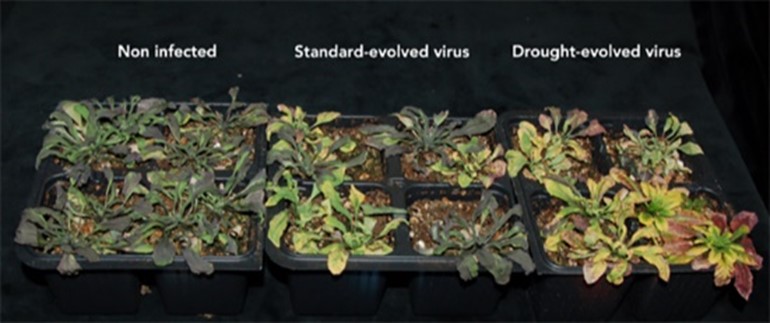Users
Social media
- More details here...
- Address
Parc Científic de la Universitat de València C/
Catedrático Agustín Escardino, 9
46980 Paterna (Valencia) Spain - Email:
iu.i2sysbio@uv.es - Phone:
(+34) 963544810
- Address
Links
Viruses can evolve to benefit the host organism, according to an I2SysBio study

Investigation
Viruses can evolve to benefit the host organism, according to an I2SysBio study

A research group from the Institute of Integrative Systems Biology (I2SysBio) confirms that a virus that affects a cruciferous plant reduces its virulence in drought conditions. It is the first time that it has been shown that the relationship between a virus and its host can evolve depending on environmental conditions. The study is published in the journal PNAS.
A research team from the Institute of Integrative Systems Biology (I2SysBio), a joint center of the University of Valencia and the Higher Council for Scientific Research (CSIC), has observed that a virus that affects a herbaceous plant of the cruciferous family can evolve to reduce its virulence in its host organism. Researchers have observed that, in drought conditions for the plant, the virus evolves its genome in such a way that it is capable of altering the circadian clock of its host, thereby preventing it from losing water and favoring its survival by up to 25% more. It is the first time that it has been documented how natural selection can change the relationship between virus and host depending on the environment, a study published in the journal Proceedings of the National Academy of Sciences (PNAS).
The work has been carried out by inoculating a virus of the genus Potyvirus, the turnip mosaic virus (TuMV, for its acronym in English), in Arabidopsis thaliana, a herbaceous plant from the cruciferous family (such as broccoli or cauliflower) widely used as a study model. The research team studied the evolution of the virus in plants under normal conditions and in drought situations by characterizing the changes (mutations) that occurred in their genes. In viruses evolved in plants with drought, they observed that the mutations were concentrated in the VPg protein, which plays a determining role in the relationship of the virus with its host.
“Under normal conditions, the virus shows its classic vision as a pathogen, by killing watered plants. However, infected plants that were subjected to drought stress conditions remained alive,” explains Santiago Elena Fito, CSIC research professor at the I2SysBio and lead author of the study. For their part, plants infected with the virus evolved in drought showed a series of changes in the genes associated with their circadian clock, the system that controls biological processes of plants such as their response to lack of water.
Attenuate a virus
Subsequently, they used variants of the virus evolved in plants subjected to drought to infect healthy individuals and others subjected to water stress. By comparing both, the research team found that the genetic changes were more pronounced in individuals with drought. “The virus variants that evolved in normal irrigated conditions continue to kill the plant, while those that evolved in plants with drought do not do so, even when inoculated in healthy and well-irrigated plants,” says Santiago Elena. This suggests that viruses adapted to plants under drought conditions cause changes in the transcription of their host's genes that may be beneficial.
According to the study, plants infected with the virus evolved under drought conditions are 25% more likely to survive water stress situations. This reveals that, under environmental stresses, a virus can be evolved to go from a parasitism relationship to a mutualistic one, where the host also has benefits (the benefit of the virus is to ensure its transmission). “It is the first time that it has been shown that a virus can be attenuated and obtain benefits for its host,” summarizes the CSIC researcher. The door opens to using modified viruses to achieve plants that are more resistant to drought.
The research team, in which the Department of Biochemistry and Molecular Biology of the University of Valencia and the Department of Agricultural and Natural Sciences of the University Jaume I of Castellón have also participated, now wants to continue this study with an animal model using the nematode Caenorhabditis elegans to verify these changes in the relationship between viruses and hosts observed in plants. We also want to check whether the variants of mutualistic viruses do not revert to their most virulent form, or if these changes affect the properties of the plants from the point of view of consumption. Pèrez-Parets, Aurelio Gómez-Cadenas, Pedro Carrasco, Santiago F. Elena, Plant virus evolution under strong drought conditions results in a transition from parasitism to mutualism



